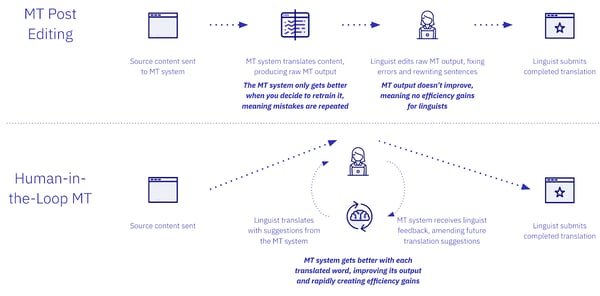Looking Towards the Future of Localization: A Recap

The translation and localization industries have changed quite a bit over the last few decades. Over the course of that time, we’ve seen the power and might of machine translation as it’s started to revolutionize the way translation is done.
Lilt’s sales strategy leader Paula Shannon knows a thing or two about where the industry has been and where it’s headed. In our recent Q&A webinar, Paula focused on adaptive neural machine translation and how it, combined with the human-in-the-loop translation approach, is changing the way linguists and localization leaders think about the translation process.
With the human-in-the-loop workflow, Paula says that the entire machine translation process becomes more efficient and more humanlike than ever before. Traditionally, raw machine translation output is reviewed and edited by a linguist, otherwise known as MT post-editing. What that leads to, however, is a decrease on both the quality and efficiency sides of the equation.
As shown in the MT post-editing portion of the graphic above, the MT system only gets better once retrained, so the same translation errors are repeated until the whole system is updated. That leads to a less efficient workflow for the linguist, as they’re constantly having to correct the same mistakes. The quality also suffers - the output is still translated solely by a machine, so linguists have to not only edit for errors but also edit for human-like prose and consistency.
What that leads to is dissatisfaction, Paula says. “Linguists don’t love post-editing, and I don’t think they’re at their best when they do it,” she says. A 2020 CSA Research study shows that 71% of linguists prefer the adaptive, human-in-the-loop translation workflow over working with raw MT output. And according to Paula, the human translator is crucial to the entire workflow.
“When we think about MT post-editing as an industry, let’s be honest: embedded in that notion is the idea that we’ll improve over time because we’re removing the human from that equation,” she says. “We should look towards the process that harnesses the most efficient, intelligent automation that’s open to human feedback. We’ll get higher value, better content out of that system.”
One of the biggest benefits of a human involved translation system is that it unlocks the real potential of machine translation to tackle marketing translation and consumer content, something that has been a challenge in the industry for a long time.
With MTPE, localization teams are doing everything they can to produce high-value content. Most notably, they’re using rich corpora and maintaining in-depth glossaries and termbases to help translators output the best content possible.
But ultimately, those translators are still editing machine-translated content. With a human-in-the-loop workflow, however, the translators are making decisions in the moment leading to more humanlike content. The system then learns from those decisions to make more informed, more human-like translations in the future.
The result? A system that can translate marketing and consumer-facing content more effectively and efficiently. That’s something that companies, no matter their size or localization maturity, can look towards.
To hear more from Paula about the current state of localization and what the future holds, watch the Looking Towards the Future of Localization webinar on-demand by clicking this link.




